Most top-of-the-line luxury sedans are two things: Big – and pricey. Except for one big luxury sedan that’s not but which is often overlooked.
Volvo’s S90.
What It Is
The S90 is Volvo’s largest, most luxurious sedan. It costs about the same as other luxury car makers’ smaller, mid-sized sedans.
Prices start at $51,850 for the Momentum trim, which is equipped with a 316 horsepower 2.0 liter four cylinder engine that’s turbocharged, supercharged . . . and mild-hybridized. It’s also paired with standard all-wheel-drive, which is generally optional in rival sedans.
Additional standard equipment includes a digital gauge cluster, nine-inch LCD touchscreen, a ten-speaker audio system, leather upholstery and a panorama sunroof.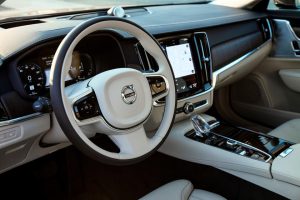
Plus several inches more backseat room than you get in the smaller, mid-sized Mercedes E-Class and BMW 5-Series sedans – which cost about the same.
The S90 also offers a 400 horsepower plug-in hybrid option that can travel about 21 miles on battery power before the gas engine kicks on to keep you going. It stickers for $60,050 with the Inscription package, which includes the option to get massaging driver and front passenger seats, a 13 speaker Bowers & Wilkins ultra-premium audio system, automated self-parking and an adjustable air suspension.
What’s New
The standard 2.0 liter engine is now paired with a 48 volt mild-hybrid system that (like other such systems found in rival sedans like the Benz E-Class sedan) cycles the gas engine off and on to increase gas mileage and lower the emissions of gasses (carbon dioxide, the inert gas that’s been made into a B movie villain bent on “changing” the “climate”).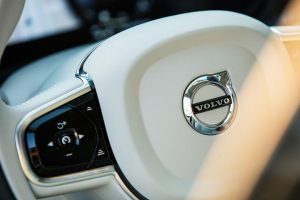
What’s Good
More size, room – and power – than the same money buys in something smaller, elsewhere.
Almost the same size – and comparable power (Inscription trim) as what you’d get in something larger, like a Benz S-Class, for about $40k less money.
Exceptionally comfortable seats, even without the optional massage.
What’s Not So Good
Trunk isn’t big (13.5 cubic feet, about what you’d get in most compact-sized sedans).
Four cylinder engine is small, irrespective of the power it makes.
You could get a loaded Toyota Avalon – about the same size and with a stronger V6 – for about $10k less.
All S90s come standard with a 2.0 liter four cylinder engine, an engine type that is becoming a kind of Universal Engine, in all kinds of cars – not just luxury cars. The reason for this is that the size is just the right size to comport with the various government regs in force while also summoning enough power – when supplemented by turbo boost – to comport with the expectations of buyers.
The Volvo’s 2.0 engine differs from all the others in one way, however.
In addition to being turbocharged it is also supercharged. The reason for that being to eliminate – not just reduce – the lag you get with just a turbo. And the reason for that is turbos don’t produce boost pressure until exhaust pressure increases and that takes a moment, leading to the lag. You push down on the gas and then exhaust gasses are made – and boost produced.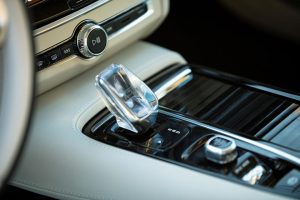
A supercharger does not rely on exhaust gas pressure to build boost. These devices are mechanically (or even electrically) powered and so build boost immediately. So why not use just a supercharger? Because superchargers – paradoxically – take a lot of power to power, whereas a turbo scavenges the free power of the engine’s spent exhaust gasses.
Volvo’s solution – to both problems – is to combine both things. The supercharger imparts immediate boost, eliminating the lag while the turbo maintains boost without the cost (of power) that relying on just a supercharger otherwise would.
End result? 316 horsepower and 295 ft.-lbs. of torque at 2,100 RPM and 0-60 in about 5.5 seconds. EPA says 22 city, 31 highway.
This being very competitive with the performance of smaller, mid-sized luxury sedans like the Mercedes E-Class, which also comes standard with a 2.0 liter four cylinder engine – but just 255 horsepower (for $56,750). You can get a stronger, 3.0 liter six/mild hybrid iteration and 362 horsepower in the Benz E . . . for $62,000.
But for $60,050 you could get an S90 with the plug-in hybrid drivetrain, 400 horsepower and zero to 60 in 4.5 seconds, an extremely quick run for a large luxury sedan.
Extremely quick, period.
Plus the ability to travel for about 21 miles on battery power, which the mild-hybrid E-Benz can’t do.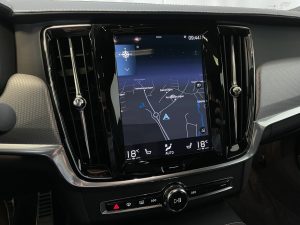
Equipped with the plug-in hybrid drivetrain, the Volvo stacks up pretty impressively against the full-sized Mercedes S-Class, which comes with the same basic 3.0 six/mild-hybrid drivetrain that’s optional in the mid-sized Benz E, tuned up to 429 horsepower. But it’s not quicker than the Volvo – due to being heavier.
Just a lot more expensive.
As in $109,800 to start expensive.
The same price-performance scheme elaborates when you compare the Volvo with the mid-and-full-size versions of BMW’s sedans, the 5 and 7 Series. Also the Audi A6 and A8.
The S90 is the bargain of the bunch, offering more standard power in a roomier car for less than its rivals charge for smaller, less powerful cars.
Performance is excellent with either of the S90’s available drivetrains, but it’s smoother with the standard (mild hybrid) drivetrain.
The turbo-supercharger set-up gives immediate – and smooth – power, without any hesitation or abruptness. The plug-in hybrid set-up is also usually smooth but under sudden, WOT throttle input, there’s sometimes a moment of apparent confusion as the electronics decide which parts of the hybrid drivetrain to engage – and how much. This being due to the 400-horse plug-in version being more reliant on the power delivered by its battery/motor side to propel the car forward.
The mild-hybrid iteration relies almost entirely on its turbo-supercharged gas engine for propulsion, relying on the 48 volt/mild-hybrid part of the drivetrain chiefly for seamless re-starts when engine power is needed after a period of coasting. This system is almost unnoticeable, which is its great virtue and the chief reason for it as otherwise, there would be noticeable – recurrent – stop/start cycling (as in less cars without the 48 volt mild-hybrid system but with the obnoxious “stop/start technology,” as it’s usually advertised).
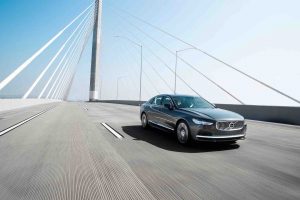
Both versions are more luxurious (i.e., comfortable) rather than sporty – as is true of other sedans on either end of the size spectrum in this class. It was once-upon-a-time the case that some of cars in this class – like the BMW 5 sedan – were four door sports cars. Some even had manual transmissions.
None of them do, anymore.
Most do have or offer some type of “active” (i.e., adjustable) suspension and various driver-selectable driving modes that alter the shift points/feel of the automatic transmission and make the throttle more sensitive to driver inputs. All of them come with pretty aggressive “sport” tires with thin sidewalls, too. But they’ve returned their big cruiser origins, even if they do have sport buckets and strike a sporty pose.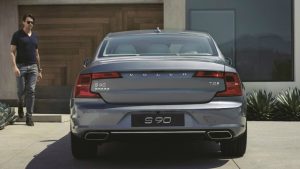
The Volvo differs in being noticeably less sporty than its primary rivals – and that’s a pleasant thing. It has sport buckets, too – but they’re the kind you’ll wish you could take out of the car and place in your TV room. They are a great place to relax – and that is fundamentally what this car is all about. Its speed is an adjunct of that – as it is uncomfortable to drive a car that lacks the power to just whisk you away from whatever you don’t want to be near anymore.
It’s not going to hang with a Caterham Super 7 in the curves – but you’ll glad it’s not a Super 7 when traffic sucks and all you want to do is . . . relax until you get home.
Splitting the difference isn’t a bad idea.
The S90 is bigger (and roomier) than comparably priced mid-sized luxury-sport sedans like the Benz E-Class and BMW 5 Series while also being nearly as big (and almost as roomy) as much higher-priced full-size luxury sport sedans like the Benz S-Class and BMW 7 Series.
It’s 200.4. inches long overall and has 40.4 inches of legroom for backseat passengers. The Mercedes E-Class sedan is 194.3 inches long and only has 36.2 inches of legroom in back. A BMW 5 Series sedan is 195.8 inches long overall and has 36.5 inches of backseat legroom.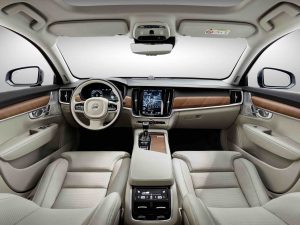
On the other end of the spectrum, a Mercedes S-Class sedan is 208.2 inches long overall and offers 44 inches of legroom for backseat passengers – as it should, for $109,800. The BMW 7 sedan is similarly sizable (207.4 inches) and spacious (44.4 inches of rearseat legroom) but it’s also a pricey proposition at nearly $90k to start (equipped with AWD, optional in this model; standard in the S90).
Also standard in the Volvo is the au currant digital/configurable dashboard layout that the others in this spectrum also come come standard with, plus a 9 inch secondary LCD touchscreen, leather seats and a panorama sunroof. Things like four-zone climate control, power side shades, rear seat heaters and an excellent 13 speaker Bowers & Wilkins ultra-premium audio rig are available – along with those massaging driver and front passenger seats mentioned earlier.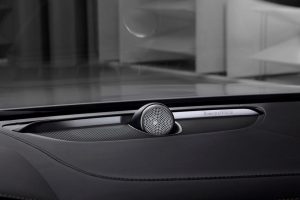
Similar things are available in rivals – on either end of the size spectrum – but the Volvo’s ace in the hole is that it offers the size (and room) those on the left side of the spectrum don’t – for much less than those on the right side of the spectrum charge for more.
The Rest
Two things are lacking here, one of them subjective..
The objective deficit is this big car’s small trunk. Just 13.5 cubic feet, which is about the same size trunk as you’d get if you were to buy a typical compact-sized sedan. It’s usually big enough. But it might be not enough if you – and three passengers – go for a road trip and need a place to put all their stuff.
Subjectively, the Volvo isn’t as recognizable as a status car. Which for some people will be the opposite of a deficit. Volvo has become kind of like what Buick was, once – a luxurious car – like a Cadillac – without flaunting it.
Like a Cadillac.
The Bottom Line
If you prefer a lower profile luxury sedan – and like paying less for more – you might want to have a look at this Volvo.
. . .
Got a question about cars, bikes, or Sickness Psychosis? Click on the “ask Eric” link and send ’em in! Or email me at EPeters952@yahoo.com if the @!** “ask Eric” button doesn’t work!
If you like what you’ve found here please consider supporting EPautos.
We depend on you to keep the wheels turning!
Our donate button is here.
If you prefer not to use PayPal, our mailing address is:
EPautos
721 Hummingbird Lane SE
Copper Hill, VA 24079
PS: Get an EPautos magnet or sticker or coaster in return for a $20 or more one-time donation or a $10 or more monthly recurring donation. (Please be sure to tell us you want a magnet or sticker or coaster – and also, provide an address, so we know where to mail the thing!)
My eBook about car buying (new and used) is also available for your favorite price – free! Click here. If that fails, email me at EPeters952@yahoo.com and I will send you a copy directly!


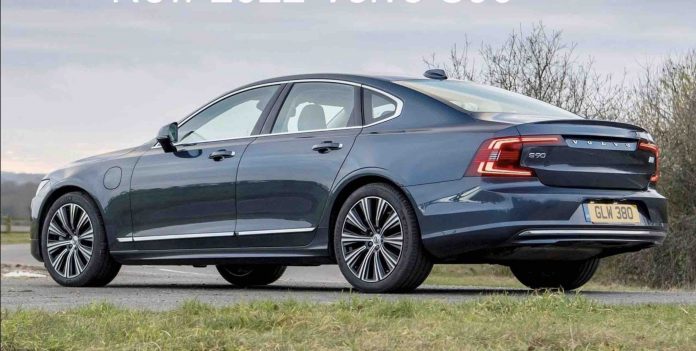

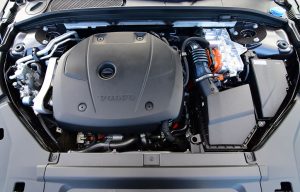
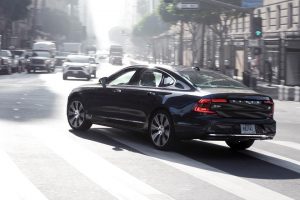









Probably a perfectly acceptable transportation appliance. I’ll never know
I owned a 2020 V60 T8 Polestar Engineered (smaller wagon) with the super- and turbo-charged 2.0 engine with the hybrid drivetrain for about 9 months. It was a dream come true for me having a fast, stealth wagon – a compromise since I’ll never be able to afford my dream car, an E63 wagon.
I can say that it was silly quick off the line and overall a really nice experience. I decided to sell it last year and used some of the proceeds to buy a 1995 850 T-5R wagon in cream yellow instead. Less speed, may more character and super rare.
This thing is governed to 110 mph according to the politically correct morons at Volvo. I’ll pass.
You can pay around 100 bucks to have the limiter removed by third parties iver the internet, but I agree that it’s a dick move.
Turbocharged, supercharged, hybridized with 48 volt electronics…. What idiot wants to pay the maintenance costs for this Hangzhou Special?
I love my Volvos. Both are 3.0 litre T6 AWD versions as I worried about the 2.0 litre super-turbo’s reliability at the time. Thankfully the new motor seems to be very reliable. I imagine my current Volvos (XC60/XC70) will be serviceable for many years to come but I like that Volvo has created replacements that are still desirable without a requirement to have all the nannies that folks with a functioning brain won’t want.
Good looking car. I’ve seen some on the road. Size is good. I would consider it but the 4cyl-only is a deal breaker for me. Don’t care that even with all the extra crap it’s pretty fast. V6-blown min., v8 preferred.
I thought it was china owned but still made in sweden?
Nice review Eric, as always.
I feel the same way Chris –
As regards all current high-end cars. These cars ought to come with V8s – or V12 – as they did, not all that long ago. Paying $50k for a four is obnoxious. Paying $100k for a V6 is ludicrous.
Volvo is China owned and made now, probably keeps the price down.
Most Volvos for North America are still made in Europe. Some cars are made in China but those are typically destined for China and Russia. At least that’s how it has been, anything could change in the future.
“Subjectively, the Volvo isn’t as recognizable as a status car. Which for some people will be the opposite of a deficit.” Another benefit of being a subdued luxury car is that in an era of rampant, unpunished crime, criminal elements are more likely to leave you alone and target drivers of more flashy brands that appeal to the nouveau riche and criminals alike. I’d feel safer in an Audi A6 or a Volvo S90 than one of their competitors.
Has anyone seen the Volvo commercial, where they brag about their car being a cell phone on wheels? I don’t remember the model, and am not finding it on you tube.